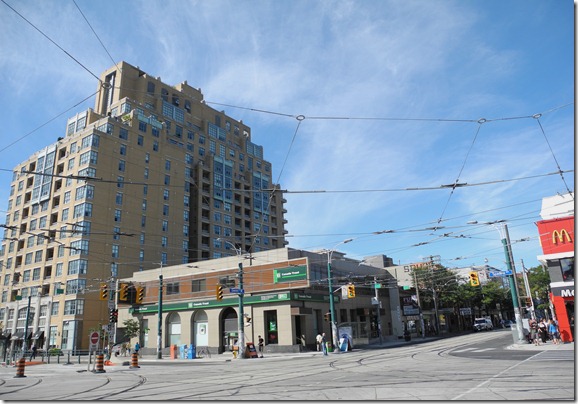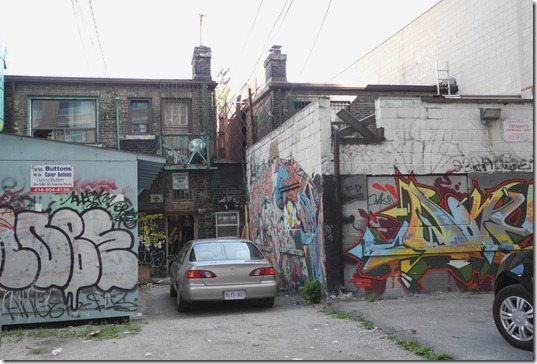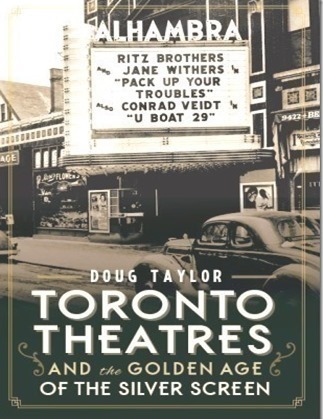The home of James Fitzgibbon was on the southwest corner of Queen West and Spadina, seen in the above photo. A bank occupies the site today, and towering beside it is the condominium The Morgan, on Richmond Street. The McDonald’s on the northwest corner is visible on the right.
James Fitzgibbon, hero of the War of 1812 and leader of the loyalist troops that raided Montgomery’s Tavern during the 1837 Rebellion, lived a short distance from the corner of Queen Street West and Spadina Avenue. Records are vague, and it is impossible to pinpoint the exact location of the house, but it known to have been on the south side of Queen Street (then named Lot Street), a short distance west of Spadina Avenue (then named Brock Street). If he were alive today, his children would be able to walk to the McDonald’s on the corner of Queen and Spadina for a “Big Mac.”
In Henry Scadding’s book, “Toronto of Old,” published in 1873, he states that the house was, “. . . on the same side (south), across the very broad Avenue (Spadina), a modest dwelling place of wood – somewhat peculiar in expression; square and rather tall for its depth and width; of dingy hue; its roof four-sided; below a number of lean-to’s and irregular extension clustering around; in front low shrubbery, a circular drive, and a wide open-barred gate.” I find this account remarkable even without its unbounded enthusiasm for the use of semi-colons.
The Toronto Directory of 1819 lists within the Fitzgibbon home on Queen Street 2 males over 16 years of age, 3 females over 16, 2 males under 16, and one female under 16. In the 1833 Toronto Directory, it states that to the west of Peter Street was the home of The Hon. John Henry, the Receiver General of the province. To the west of his home was the home of James Fitzgibbon. Its exact location is not given, but Henry Scadding stated that it was immediately west of Spadina.
The 1837 Directory simply gives Fitzgibbon’s home as being on Lot Street (Queen Street), and that he was Chief Clerk of the House of Assembly. In 1847, Fitzgibbon returned to England, and his son assumed ownership of the property. The Toronto Directory of 1862 lists rows of shops/homes on Queen Street, west of Spadina, with no mention of the Fitzgibbon home. It is assumed that the home had been demolished prior to this year.
James Fitzgibbon had a distinguished career in the town of York, which was renamed Toronto in 1834. He entered the Upper Canada in 1802, the same year as General Brock. At that time he was a young lieutenant. In Europe, both he and Brock had fought in the Napoleonic Wars. Fitzgibbon was one of Brock’s favourite officers, having secured for him several promotions without the usual payment of funds. Brock encouraged Fitzgibbon to pursue private studies to improve his education. Early in the year 1812, Fitzgibbon resigned his army commission to study full-time, in hopes of eventually earning further promotions. When hostilities broke out with the United States in June of 1812, he resumed his military career.
In June of 1813, Laura Secord who travelled through the woods at night to warn Fitzgibbon of the impending American attack on Beaver Dams. Due to her information, Fitzgibbon captured 450 enemy infantrymen, 50 cavalrymen, 2 field guns, and a partridge in a pear tree. He accomplished this by bluffing the enemy into surrendering, by offering to prevent the Indians from attacking. The Americans were unaware that Fitzgibbon commanded just forty-eight soldiers, and a band of only 400 Indians. The enemy force had been superior in both numbers and artillery.
IN 1823, James Fitzgibbon became Adjutant-General of Militia for Upper Canada. William Halton, who was now back in England, sold the Camden site to James Fitzgibbon, the transaction arranged through his lawyer in Upper Canada, Duncan Cameron. The title to the land where the condominium 50 Camden is located today, was registered on March 8, 1817, the price paid being 270 pounds. Throughout the next few years, Fitzgibbon was involved in various financial endeavours, and used his Camden property as collateral.
In 1826, James Fitzgibbon became involved in another historic event in the town of York. He begrudgingly collected the funds that a court had awarded to William Lyon Mackenzie. The money was compensation for his printing press, which had been thrown into the lake by a group of young Tory hotheads. As Fitzgibbon had openly sided with the Tories, the affair did not endear him to Mackenzie.
In 1827, Fitzgibbon secured the position of Clerk of the Canadian House of Assembly. Mackenzie viewed the appointment as a sinecure position that was undeserving. In his newspaper, he severely criticized Fitzgibbon.
In 1832, a riot broke out in the town, the feud involving a struggle between the Reformers, led by Mackenzie, and the Tories who sided with the Family Compact. Fitzgibbon intervened in the fight on the street in front of Mackenzie’s printing shop. Not to be outdone, Mackenzie dared Fitzgibbon to call out the troops.
Fitzgibbon threatened to arrest Mackenzie and charge him in court with being the instigator of the riot. Mackenzie backed down, and Fitzgibbon escorted him to his home, and shoved him inside the front door. It was a colourful and action-packed scene. Mackenzie retreated to wait for a more opportune moment, while Fitzgibbon basked in the sunlight of adoration from his powerful friends.
James Fitzgibbon, a hero of the War of 1812, and the owner of the Camden property, was now a well-known figure in the town of York. Henry Scadding, in his book, “Toronto of Old,” referred to Fitzgibbon as one of the reverend seniors, who assembled habitually in the church at York.
This was the old wooden church of St. James, at King and Church Streets, not the structure of today. Scadding wrote the following about Fitzgibbon: His tall, muscular figure, ever in buoyant motion; his grey good-humoured, vivacious eye beaming out from underneath a bushy, light-coloured eyebrow; the cheery ring of his voice and its animated utterances were familiar to everyone. In a midst of a gathering of the young, whether in the schoolroom or the playground, his presence was always warmly hailed. They at once recognized him as a sympathizer with themselves, in their ways and wants, and had ever ready for them words of hope and encouragement.
Other sources stated: Fitzgibbon was a person of military bearing and exceptional strength, possessing both courage and wit.
Following the death of his wide, Mary, Fitzgibbon returned to En gland in 1847. Due to his service to the British Empire, the crown granted him tenancy of a small cottage built into the walls of Windsor Castle. He died in December of 1863, and was buried within the crypt of St. George’s Castle.
Much of the above information is from the book, “The Villages Within,” a humorous account of the history of Toronto, and a detailed examination of the Kensington Market, Queen Street West, and the Kings District around King Street and Spadina Avenue. The book was nominated for the Toronto Heritage Awards. For a link to this book:
https://tayloronhistory.com/the-villages-within/
These graffiti marked buildings to the south and west of the bank on the corner of Queen and Spadina are likely on the site of the Fitzgibbon home, as the house was set back from Queen Street, and was most likely also set back from Spadina Avenue. The brick buildings behind the garages face onto Queen Street.
To view the Home Page for this blog: https://tayloronhistory.com/
Links to other posts about the history of Toronto and its buildings:
https://tayloronhistory.com/2013/10/08/links-to-historic-architecture-of-torontotayloronhistory-com/
Links to posts about Toronto’s movie houses—past and present.
https://tayloronhistory.com/2013/10/09/links-to-toronto-old-movie-housestayloronhistory-com/
Recent publication entitled “Toronto’s Theatres and the Golden Age of the Silver Screen,” by the author of this blog. The publication explores 50 of Toronto’s old theatres and contains over 80 archival photographs of the facades, marquees and interiors of the theatres. It also relates anecdotes and stories from those who experienced these grand old movie houses.
To place an order for this book:
Theatres Included in the Book
Chapter One – The Early Years—Nickelodeons and the First Theatres in Toronto
Theatorium (Red Mill) Theatre—Toronto’s First Movie Experience and First Permanent Movie Theatre, Auditorium (Avenue, PIckford), Colonial Theatre (the Bay), thePhotodome, Revue Theatre, Picture Palace (Royal George), Big Nickel (National, Rio), Madison Theatre (Midtown, Capri, Eden, Bloor Cinema, Bloor Street Hot Docs), Theatre Without a Name (Pastime, Prince Edward, Fox)
Chapter Two – The Great Movie Palaces – The End of the Nickelodeons
Loew’s Yonge Street (Elgin/Winter Garden), Shea’s Hippodrome, The Allen (Tivoli), Pantages (Imperial, Imperial Six, Ed Mirvish), Loew’s Uptown
Chapter Three – Smaller Theatres in the pre-1920s and 1920s
Oakwood, Broadway, Carlton on Parliament Street, Victory on Yonge Street (Embassy, Astor, Showcase, Federal, New Yorker, Panasonic), Allan’s Danforth (Century, Titania, Music Hall), Parkdale, Alhambra (Baronet, Eve), St. Clair, Standard (Strand, Victory, Golden Harvest), Palace, Bedford (Park), Hudson (Mount Pleasant), Belsize (Crest, Regent), Runnymede
Chapter Four – Theatres During the 1930s, the Great Depression
Grant ,Hollywood, Oriole (Cinema, International Cinema), Eglinton, Casino, Radio City, Paramount, Scarboro, Paradise (Eve’s Paradise), State (Bloordale), Colony, Bellevue (Lux, Elektra, Lido), Kingsway, Pylon (Royal, Golden Princess), Metro
Chapter Five – Theatres in the 1940s – The Second World War and the Post-War Years
University, Odeon Fairlawn, Vaughan, Odeon Danforth, Glendale, Odeon Hyland, Nortown, Willow, Downtown, Odeon Carlton, Donlands, Biltmore, Odeon Humber, Town Cinema
Chapter Six – The 1950s Theatres
Savoy (Coronet), Westwood
Chapter Seven – Cineplex and Multi-screen Complexes
Cineplex Eaton Centre, Cineplex Odeon Varsity, Scotiabank Cineplex, Dundas Square Cineplex, The Bell Lightbox (TIFF)





Congratulations on a wonderful summary of the life of one who contributed to the colourful history of Toronto and Upper Canada. As to a more exact location of James Fitzgibbon’s Lot Street and Spadina Avenue home, you will likely find the 1834 map of Toronto of interest, located at http://oldtorontomaps.blogspot.ca/2013/02/1834-bonnycastletazewell-city-of.html